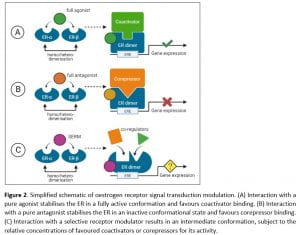Spotlight on Tamoxifen
Pharmacology and Drug Action (MEDC0013) was one of my favourite modules of Year 2. I really enjoyed going over the physiology learnt in Year 1 and applying this knowledge to understand the mechanism of action of many important drugs which I had only heard of before.
Part of the assessment for this module consisted in writing an essay about a drug of choice: this could be any compound (legal or illegal, natural or synthetic, etc.) which has an effect when introduced in the body. For the chosen drug we had to describe:
- the history of discovery and development,
- the mechanism of action, and
- the social impact.
How to choose?
Choosing which drug to work on was the first challenging step. As cancer biology is one of my favourite fields, I was eager to find an interesting compound with an application in cancer treatment. Still, there are sooo many anticancer drugs out there, I had to narrow down my choices!
I then remembered about a drug called tamoxifen which had particularly impressed me during a lecture on breast cancer for the Molecular Basis of Disease module. Tamoxifen seemed to have a very intriguing history – indeed it was originally synthesised as a contraceptive pill! – and the lecturer had referred to it as the first targeted anticancer therapy, so I did a little more research…
I found that so much work had been published on tamoxifen, the most prescribed breast cancer drug for years! Progress in the understanding of its mechanism of action over years of research has also led to the discovery of a new class of drugs, the selective oestrogen receptor modulators. I was bound to look into this landmark breast cancer drug.
What have I learnt?
Through this assessment I have definitely learnt a great deal about tamoxifen, breast cancer, oestrogen receptors and more; I am confident that this knowledge will turn out useful even if I don’t continue along the cancer research pathway in the future (although I would hope to!). In addition to improving my scientific writing skills, I have also worked on my figure-drawing skills (please see below a schematic representation of signal transduction by oestrogen receptors).
By reading about tamoxifen I have also realised how clinical trials are key for drug testing in general and for cancer therapeutics research in particular. In fact, the use of tamoxifen has radically changed throughout the years thanks to clinical observations following several clinical trials – from being a short-term palliative therapy for metastatic breast cancer, tamoxifen was actually found to be most effective as a long-term adjuvant (post-operative) treatment in oestrogen-receptor-positive breast cancer in premenopausal women.
Furthermore, this piece of coursework has shown me the importance of looking back at the past: understanding the reasoning behind a discovery is an important part of the learning process for uncovering something new in the future.
If you are interested in learning more about tamoxifen, please take a look at my essay here 🙂
